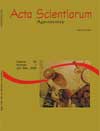<b>Response of Malaysian cabbage (<em>Brassica chinensis</em> L. var. <em>parachinensis</em> (Bailey) Sinskaja) to nutritional deficiency</b> - DOI: 10.4025/actasciagron.v31i2.844
Keywords:
Brassicaceae, nonheading Chinese cabbage, flowering white cabbage, mineral nutrition, tsoi sum
Abstract
Brassica chinensis var. parachinensis is a vegetable with short cycle, which was introduced in Brazil in 1992 due to its high nutritional qualities. It presents high concentration of β-carotene, vitamin C, Ca, and Fe, becoming an important food for the prevention of anemia. The aim of this paper was to evaluate the biological and agronomic productivity of plants grown under N, P, K, Ca, Mg, S, B, Cu, Fe, Mn, Mo, and Zn deficiency. The results were compared with plants grown with all macro and micronutrients. Plants cultured without N and P completed their cycle, but had lower yield than those cultured with complete nutrition. Additionally, they had green-grayish leaves, and purple petiole and veins. Plants cultured without B died between 30 and 37 days after sowing, and without S they did not produce fruits. These results show the importance of S and B to this Brassicaceae.Downloads
Download data is not yet available.
Published
2009-05-14
How to Cite
Mota, G. M. F. da, Sousa, E. R., & Ranal, M. A. (2009). <b>Response of Malaysian cabbage (<em>Brassica chinensis</em> L. var. <em>parachinensis</em> (Bailey) Sinskaja) to nutritional deficiency</b> - DOI: 10.4025/actasciagron.v31i2.844. Acta Scientiarum. Agronomy, 31(2), 321-329. https://doi.org/10.4025/actasciagron.v31i2.844
Issue
Section
Crop Production
DECLARATION OF ORIGINALITY AND COPYRIGHTS
I Declare that current article is original and has not been submitted for publication, in part or in whole, to any other national or international journal.
The copyrights belong exclusively to the authors. Published content is licensed under Creative Commons Attribution 4.0 (CC BY 4.0) guidelines, which allows sharing (copy and distribution of the material in any medium or format) and adaptation (remix, transform, and build upon the material) for any purpose, even commercially, under the terms of attribution.
2.0
2019CiteScore
60th percentile
Powered by 

2.0
2019CiteScore
60th percentile
Powered by 



















































